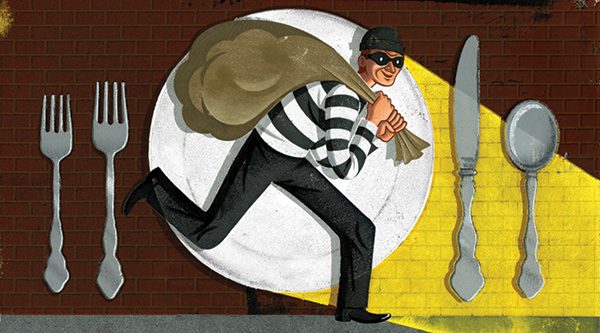
Before he was kidnapped, Highly—the beloved, 3-foot tall, roughly 80-pound Borzoi hound with a shiny nose—had long and faithfully stood guard just inside the front door of Highlawn Pavilion, the upscale restaurant and catering facility atop Eagle Rock Reservation in West Orange. Then one day several years ago, after a wedding, he disappeared.
The staff was shocked. No way Highly would run away, they agreed. After all, he is a bronze statue. Somebody had to have swiped him.
When you run a restaurant, you worry about your customers. Will they come, enjoy the food, trip over a champagne bucket, abuse a server, get food poisoning, sue? But there is something else restaurateurs worry about, much more than you’d think: customers stealing stuff.
Ashtrays used to be the big thing. Kurt Knowles, vice president and co-owner of the family company whose properties include Highlawn and the Manor, remembers the days when they bought “carloads” of white ashtrays emblazoned in gold with the Manor’s wrought-iron gate logo. “It was amazing how fast they would go,” he says. Finally the family decided to give each guest an ashtray as a goodwill gesture and chalk up the cost as an advertising expense.
No-smoking laws ended the ashtray era, perhaps driving patrons to new frontiers of effrontery. At CulinAriane in Montclair, one of the silver-plated 1940s sugar bowls was taken on three separate occasions, leaving a mound of loose granules on the tablecloth. Each bowl was eventually returned: one dropped on the grass at the curb, another hung in a bag on the doorknob, the third placed on a chair in the dining room before service began.
At Maritime Parc in Jersey City, chef/owner Chris Siversen has not been so lucky. Potted plants walk—small succulents as well as numerous vases in the foyer filled with decorative branches 3½ feet tall. Customers apparently don’t understand, he says, that “they pay for a meal, not a parting gift of memorabilia.”
People steal anything that isn’t nailed down, goes the old expression. Siversen took it to heart. Customers used to nab porcelain soap dispensers equally from the men’s and ladies’ rooms—until he literally began gluing them down with epoxy. Now they settle for the stainless steel plungers, which easily unscrew (dripping telltale soap?). As Bob Dylan noted half a century ago, “The pumps don’t work ’cause the vandals took the handles.”
David Felton, executive chef of Ninety Acres in Peapack/Gladstone, recalls a case of lavatory larceny (at another restaurant) in which a customer—in a decor-driven eureka moment—cut a 3-by-5-inch swatch out of the wallpaper of the unisex bathroom. “The problem,” says Felton, “is that you have to replace the whole sheet because it was a random pattern and too hard to match a piece.”
Some guests hunger for a bigger bite. In the ladies’ room of Alice’s Restaurant in Lake Hopatcong, a sheet of galvanized metal art hung on the wall opposite the sink. Backwards letters had been cut into it so that its 30-word welcoming message would read correctly when seen in the mirror. It vanished one Saturday night. A security camera in the hall revealed that four women had entered the bathroom together. Three quickly came out and stationed themselves by the door.
A few minutes later, the perp emerged with the 22-by-20-inch metal work “under her right arm and a large bag slung over her shoulder to help cover it up,” says executive chef David Drake. “They walked out as a group, past the hostess. Since the table was a walk-in, we had no info on them and there was nothing we could do. As I recall,” Drake adds, “the relief was attached to the wall by Phillips-head screws, so she must have come prepared.”
Not every thief bothers to conceal. Sam Mickail, chef/partner at Sam Mickail’s Cut Steakhouse in West Orange, recalls two well-dressed ladies ordering martinis at the bar when he was at Frank’s Waterside in North Bergen. Draining their drinks, the ladies carefully tucked the glasses into their Louis Vuitton bags and asked for the check. Mickail obliged, silently adding $14 for each glass. The ladies paid without a word.
“The look on their faces was worth a million dollars,” Mickail says. “We thanked them for their business and wished them a lovely evening.”
As for Highlawn’s Highly, two days after the wedding, Knowles received a phone call from the groom. Mortified, he explained that his best man had pulled a prank, depositing the metal mascot in the backseat of his car, where he and his bride were shocked to discover it after they got home. The groom pleaded for clemency for his friend, and Knowles agreed. Highly returned to duty—a heavy chain leash around his neck, the other end bolted to the wall.
